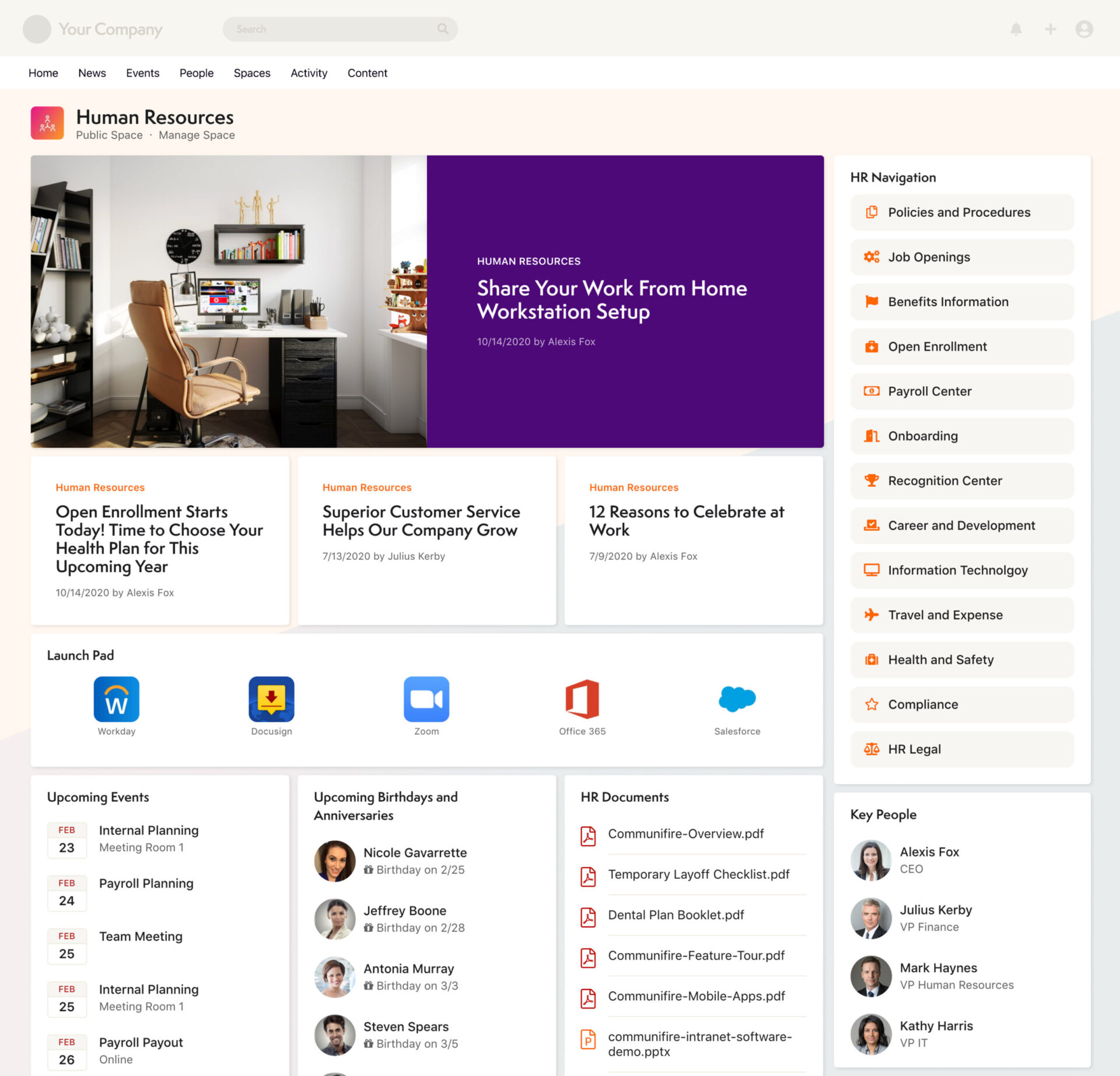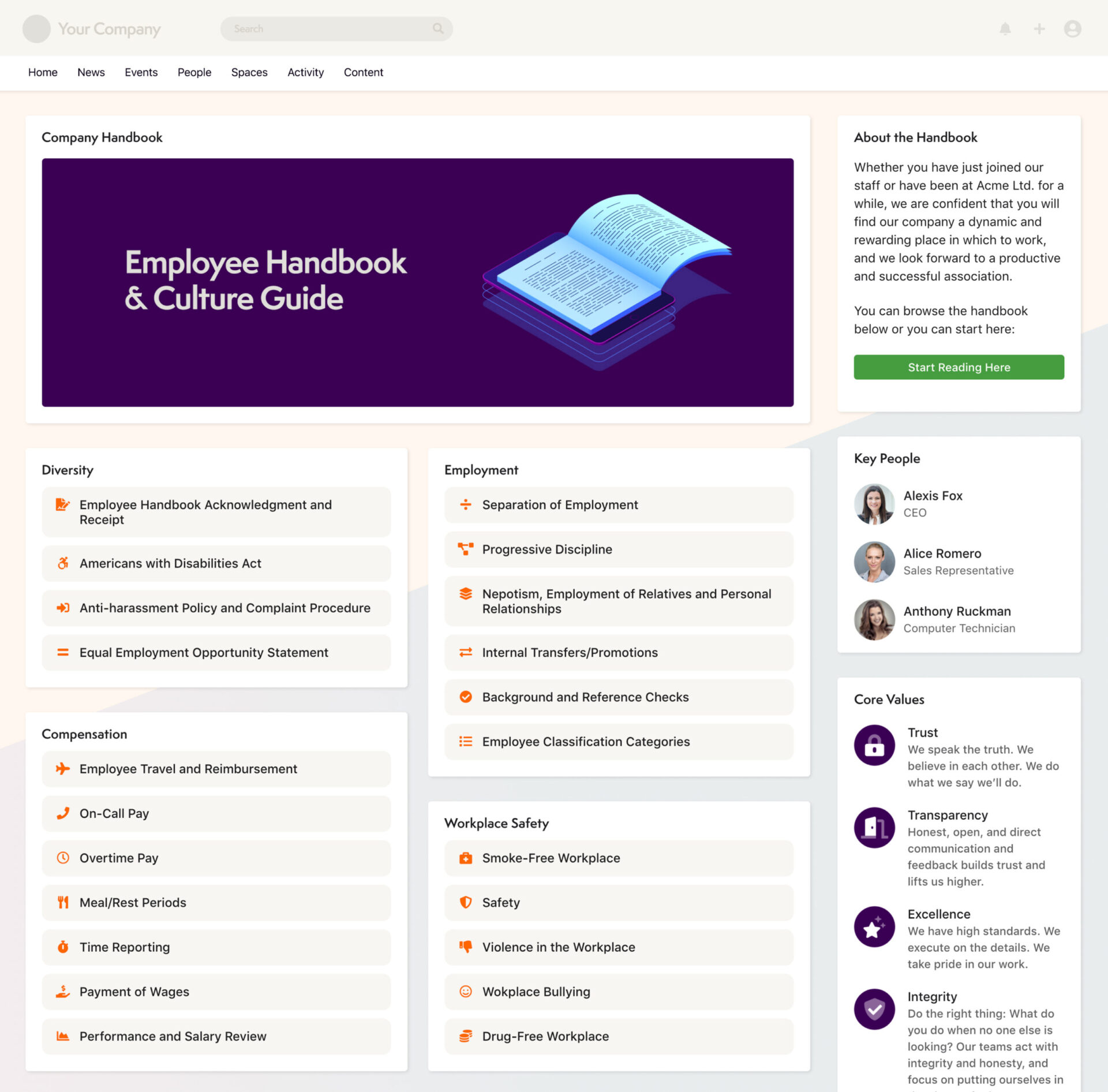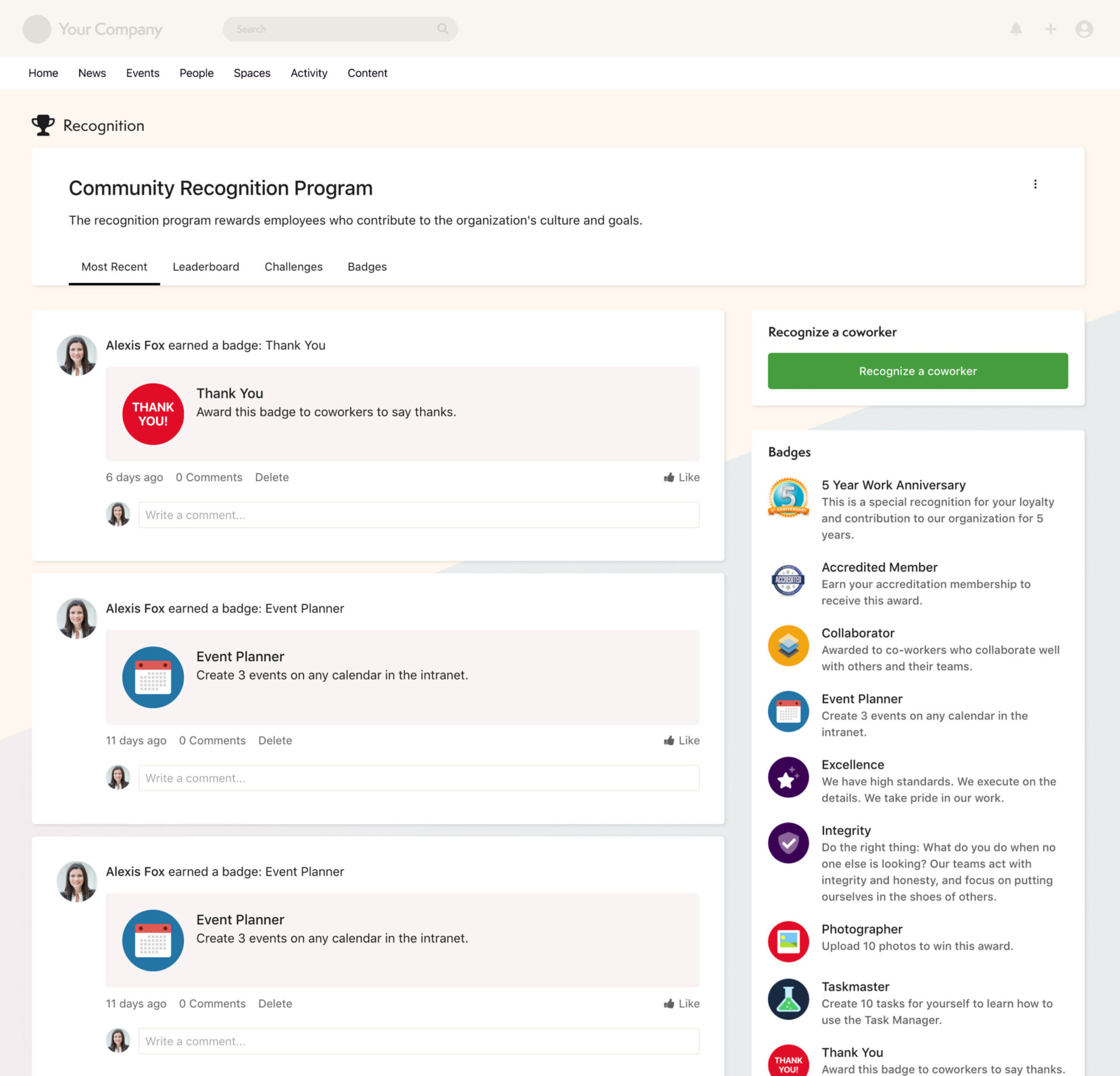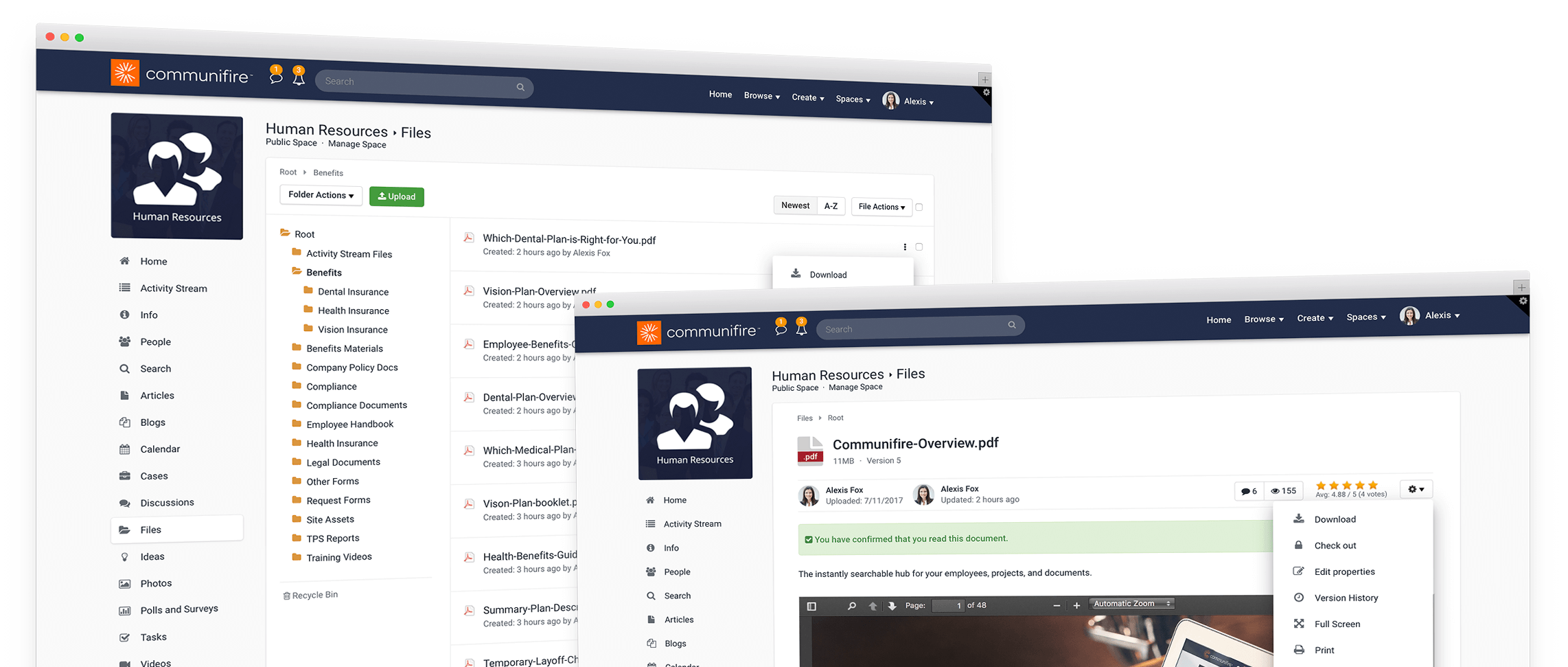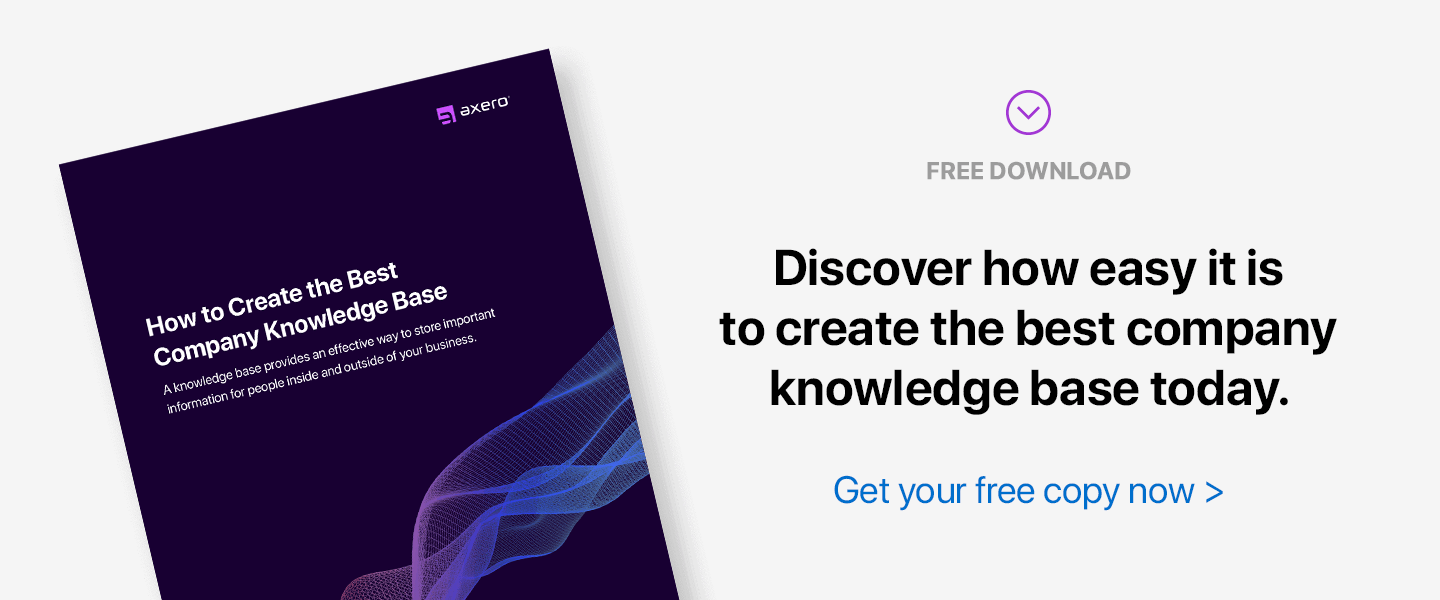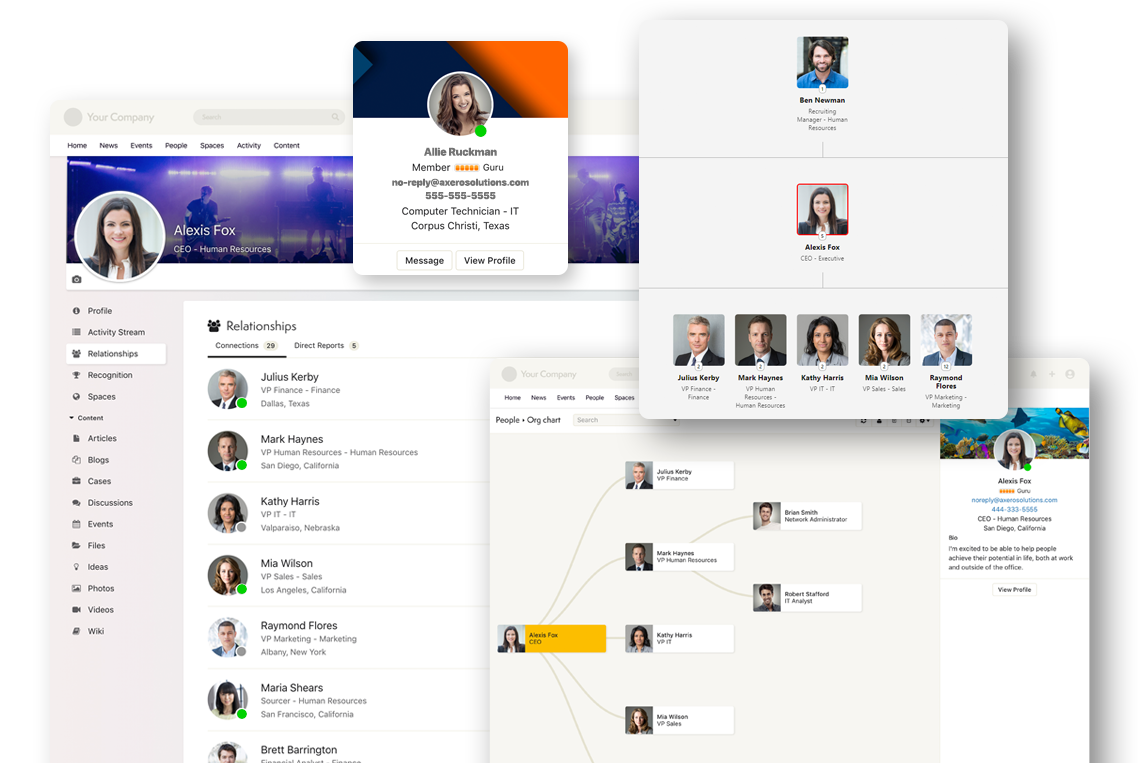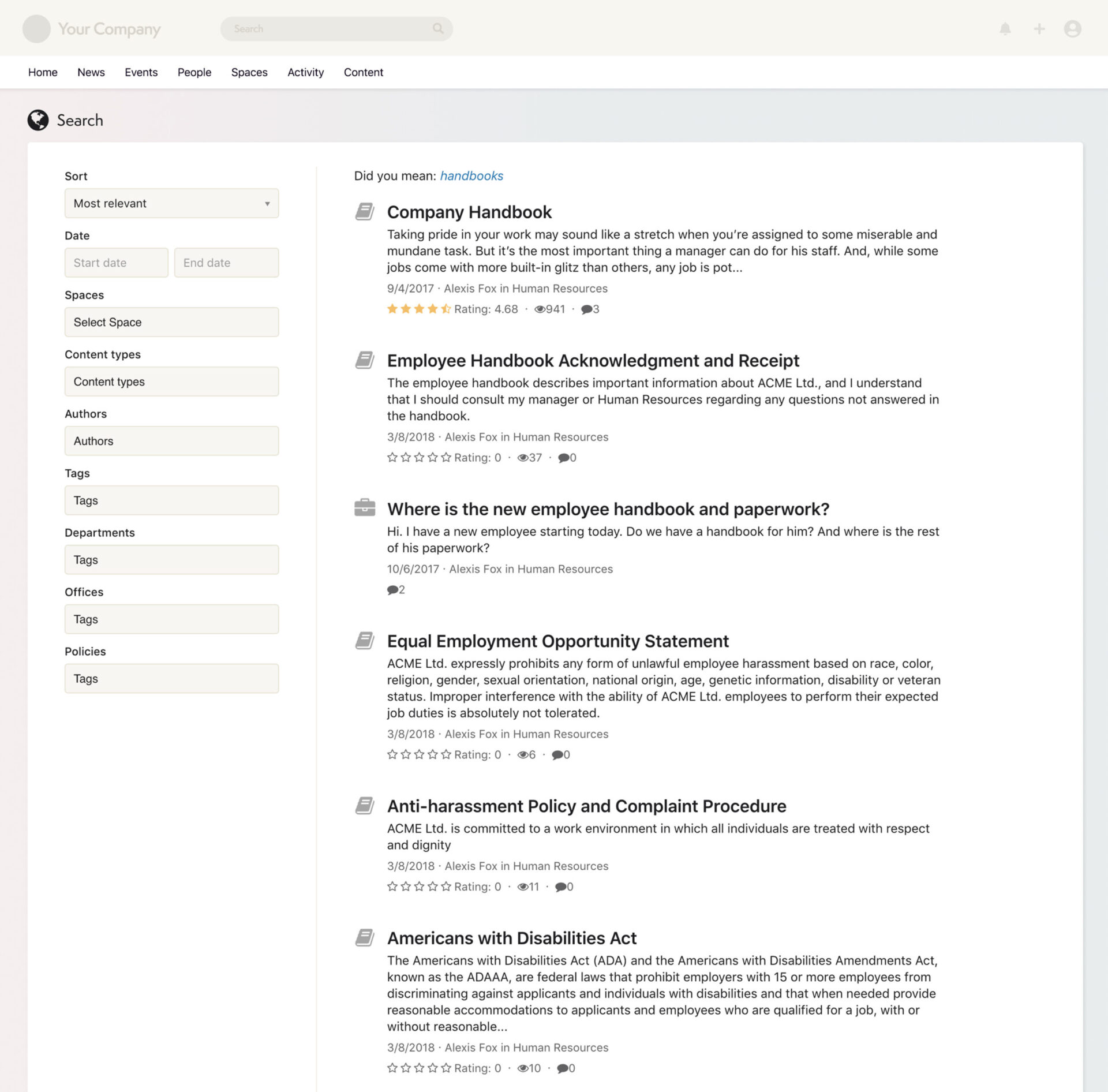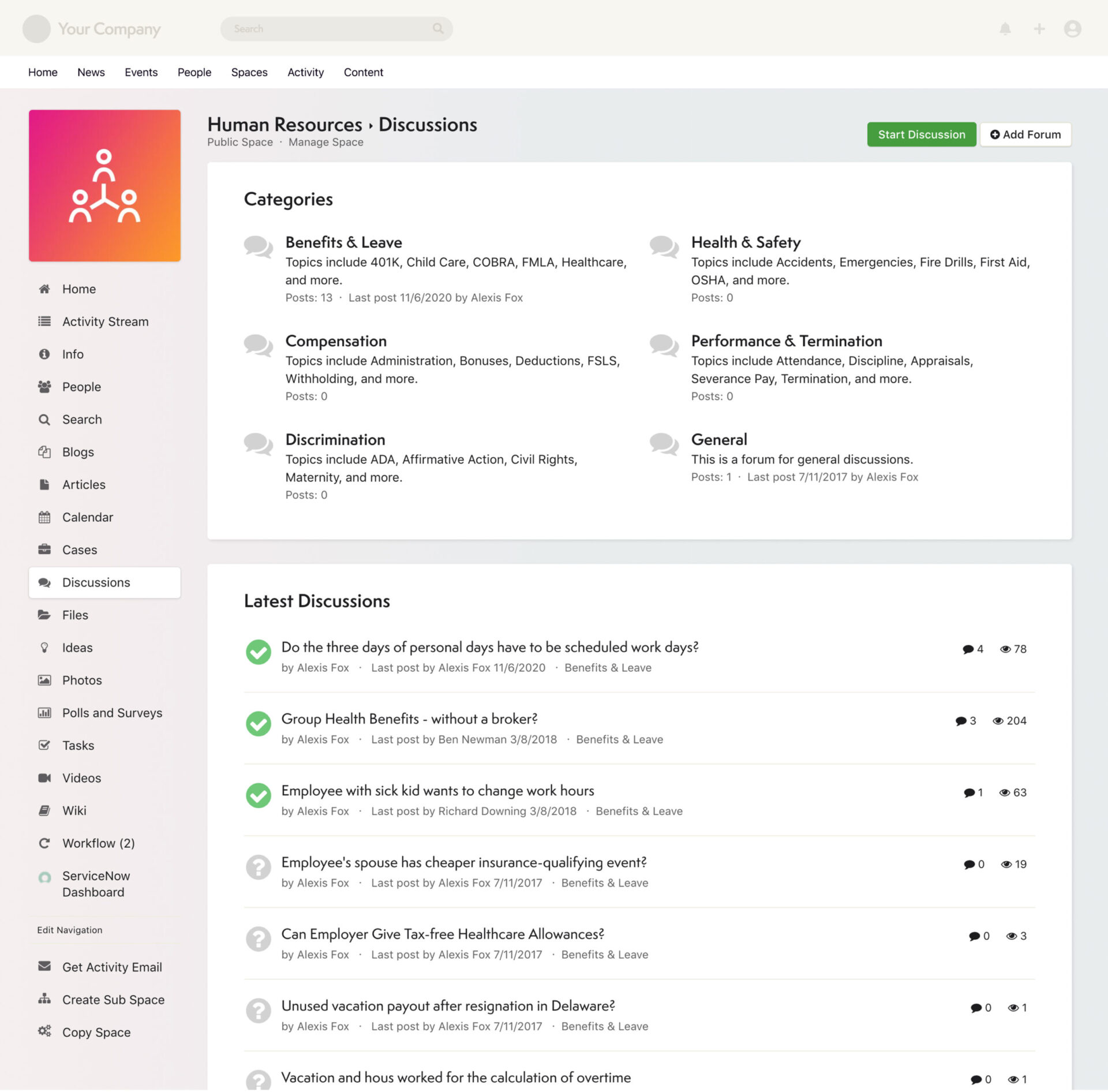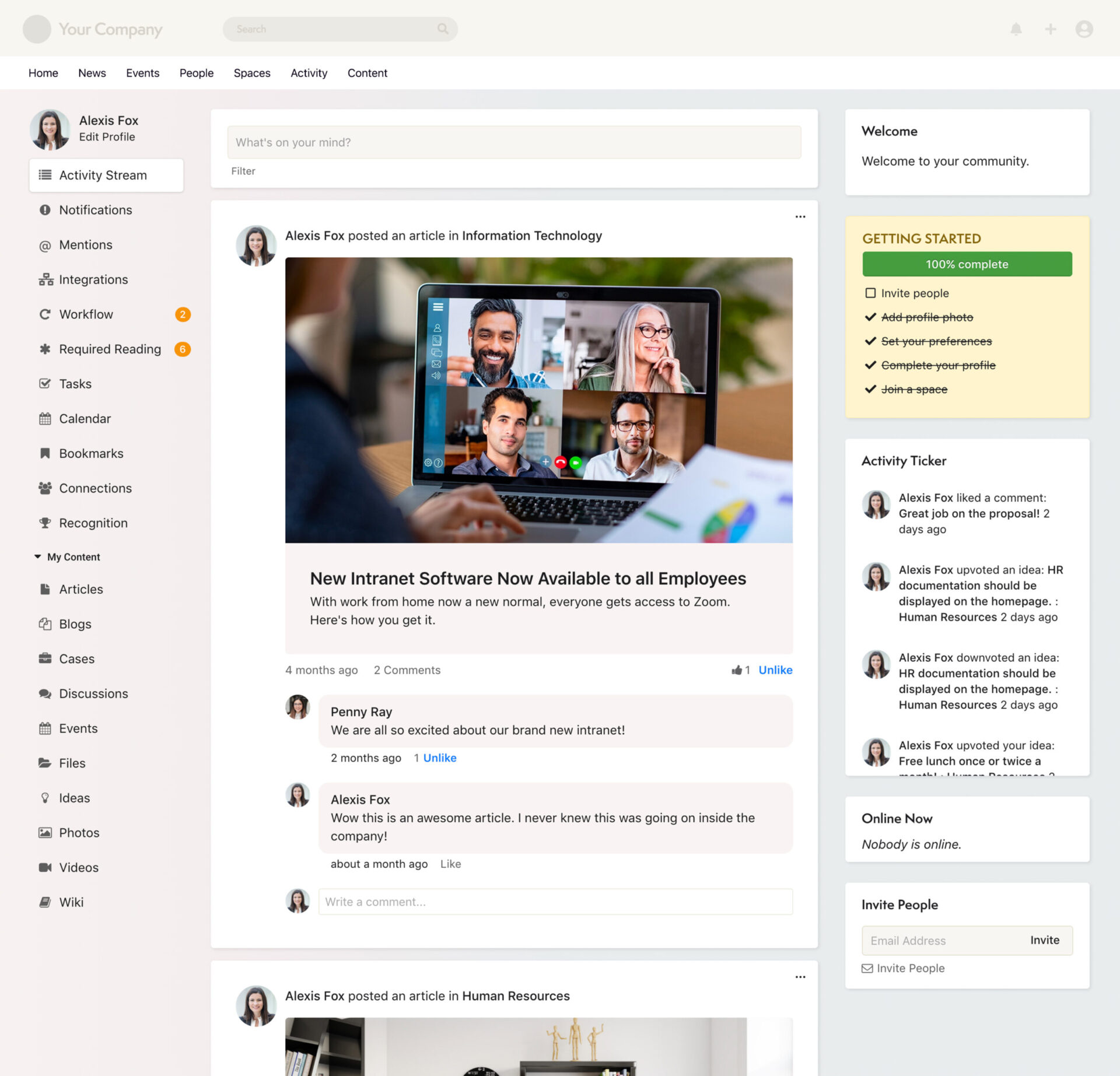Building a knowledge base that’s effective is crucial for businesses. Why? Because people need information to do their jobs—and really, to do anything! Knowledge bases serve as your organization’s library where employees can find and receive the information they need to do their jobs.
Many workplaces, though, miss the mark with how they set up their knowledge bases and how they share crucial content with departments. In fact, 83% respondents of a CSO Insights report said they have problems accessing data they need.
This falls back on the knowledge base tools and strategy you have in place—both elements need to support how your teams work, not add barriers. Intranet software allows you to build knowledge, centralize documents, and streamline communication. Intranets empower you to make the most out of your knowledge by providing your entire workplace one hub to efficiently onboard, support customers, complete projects, and contribute to your company’s overall success.
Let’s take a look at how you can build knowledge with an intranet and provide your teams with knowledge bases that connect them with the information they need.
Table of Contents
A knowledge base solution, defined.
When people talk about a knowledge base, they often think about an external knowledge base, which is built to help customers find answers to their questions or problems and streamline customer experience (Adobe Help Centre is an excellent example of an external knowledge base).
An internal knowledge base, however, is built to give your employees access to company information and departmental resources to help them do their job better. Your employees are no different than the everyday consumer: they expect instant access to information. That’s why a knowledge base is so valuable because it serves as a wikipedia for your employees.
To make sure we’re all on the same page, let’s dive into the world of internal knowledge bases!
A knowledge base is where all of your internal information is stored. There are many knowledge management trends that you can use but a good starting point is to focus on your company strategy. The kind of system you use and the knowledge management strategy you have in place can make the world of a difference for how people interact, locate, and use information to accomplish their goals.
So, you want to build a company knowledge base. We think it is best to ask yourself (and perhaps your team) these questions to set you up for success and keep employee benefits top of mind.
What are the main goals and objectives of the knowledge base?
You first need to clarify the purpose and intended outcomes of the knowledge base. Is it for centralized information access? Is it for streamlining employee onboarding and training processes? Is it for succession planning? Maybe you want knowledge bases for all three?
You don’t have to narrow them down to only one, but you should be clear about what you want out of building knowledge bases to align your efforts and ensure that they meet the needs of your organization. A knowledge base is designed for organization, so take an organized approach for how you want to create each knowledge base and set up your company’s online resources.
For instance you can create a knowledge base for onboarding all new hires to get them acquainted with your company culture and policies. But your new hire in your support team will need different resources than your new internal comms coordinator. With a knowledge base, you can further segment and organize these different training materials into their own standalone hubs.
Who are the primary users of the knowledge base?
Once you establish your goals and objectives, it is time to identify the target audience for each specific knowledge base, such as your leadership team, departments, or specific groups within a department, to tailor the content and structure accordingly.
For example, if you want a knowledge base to onboard new employees, the target audience is, naturally, new joiners. The content can range from the employee handbook and company policies to brand guidelines and software user manuals.
Here, Axero allows you to organize your content on department or team levels within your knowledge base software. Every group in your organization gets their own space where employees can access their files and directors can easily upload new documents and create content!
What are the key topics or areas that need to be covered?
You (and ideally everyone within your organization) should be aware that a knowledge base is not a junkyard for every single file ever created in the entire history of your business. And that is why it’s important to determine the core subjects for each knowledge base and be selective about what you want to live there.
The goal is to cover essential topics that address common questions, procedures, and areas of expertise within a division.
How will the knowledge base be organized?
Consider the structure and categorization of information within the knowledge base. Will it be organized by topics, departments, or a combination of both? Ensuring a logical and intuitive knowledge base structure will make it easier for users to navigate and find the information they need.
With Axero, you have many ways to organize your internal knowledge base. You can segment knowledge bases by department or workspaces—so the IT knowledge base, for instance, can live in the IT workspace. You can also dedicate entire spaces to one knowledge base, too! These can be easily accessible tabs on your main homepage so users have instant access to critical documents at all times.
What format(s) should the knowledge base support?
When you build a house, you consider different rooms and the functions they serve under one roof. Building a knowledge base is not much different.
A good knowledge base solution (like Axero!) should store different types or formats of content, such as how to articles, video tutorials, infographics, or interactive wikis. To give you full reign over how you want to display information, you can create knowledge base articles that centralize specific information your users need. The beauty of knowledge base articles is that they give you full reign to display your content and information how you want (learn more here!). This helps accommodate different learning styles and preferences and makes your knowledge easily digestible that’s tailored to the content itself.
How will the knowledge base be maintained and updated?
Establish a plan for regular content review, updates, and additions to ensure the information remains accurate, relevant, and up to date. Axero lets you set future publishing and content expiration dates, allowing complete control of knowledge base content, file versions, roles, and permissions—while seamlessly maintaining relevancy and value.
While everyone, and we mean everyone, should feel comfortable enough to contribute to the company knowledge base, it might be best to also determine who will be responsible for these tasks and how they will be managed.
How will the knowledge base be accessed?
Consider the platform or software that will host the knowledge base. Will it be your intranet, a cloud-based solution, or integrated into existing tools and systems? Determine the accessibility requirements and available resources.
Most organizations use Axero for knowledge management and knowledge base features. Depending on how you intend to leverage your new intranet, our ROI calculator simulates the potential return on investment that your organization could realize and can serve as a benchmark for tracking ROI over the course of the initiative.
How will the knowledge base be promoted and encouraged for use?
Define user adoption strategies to promote awareness and encourage your employees to utilize the knowledge base. This can include training sessions, recognition, or incentives for contributions.
For example, you can hold training sessions dedicated to different aspects of your knowledge base, such as publishing tools, file sync and sharing, and collaborative governance. Show them how to write a knowledge base article to see how easy it is to be a contributor—and maybe even offer a gift card for the first 10 authors! To maintain value for your users, it’s important to continually create content to ensure your knowledge base remains dynamic, relevant, and a continual comprehensive resource for your people.
How will the knowledge base support collaboration and feedback?
Explore social features that allow users to contribute their knowledge, provide feedback, and engage in discussions. Foster a collaborative environment where employees can collectively enhance the knowledge base content.
Axero’s ideation tool lets people vote and comment. You can also segment ideas with categories, tags, highest voted, most recent or viewed, and most comments. This way, collaboration within and across teams comes naturally, resulting in increased productivity, improved problem-solving, and heightened engagement, to name a few!
How will the knowledge base be measured and evaluated?
Define metrics and key performance indicators (KPIs) to assess the effectiveness and impact of your knowledge base. This can include usage analytics, user satisfaction surveys, or tracking improvements in productivity or problem resolution.
Why intranet software is ideal for building a knowledge base.
1. Capturing knowledge.
First and foremost, you must be able to capture knowledge effectively. Knowledge management is a core function built into intranets—making it the ideal solution to support staff with internal resources and information.
Knowledge management is the process of capturing, developing, sharing, and using knowledge within a company or organization.
Knowledge can range from information in emails and Slack messages, to spreadsheets, video demonstrations, blogs, and manuals. Capturing and building a knowledge base takes this stored information and puts it into a format where people can easily access and use it.
Whether you’re building a knowledge base for your legal team to manage policies and approvals, or for your sales team to centralize best practices for demos and navigating customer questions, your company benefits from having immediate access to this knowledge whenever needed.
Using knowledge management tools to capture and share knowledge is essential to effective growth and communication within an organization. This also increases efficiency and productivity.
2. Increasing collaboration.
Intranet software enables teams and organizations to collaborate effectively, which moves projects forward and opens the door for more innovation.
Intranets accelerate knowledge capture and the process of discovery and understanding.
When employees can easily share their insight and knowledge to an existing knowledge base, you provide a more comprehensive library founded by the people who know your company the best: your employees.
Just as consumers today use social networks to share their ideas, experiences, and opinions, businesses need to become more social, too. A modern intranet allows you to leverage collaboration and engagement between teams and employees by bringing everyone together in an interactive space. Departments have their own site where people can brainstorm and share ideas easily.
3. Removing information silos.
Information silos is a common problem that often leads to roadblocks, confusion, and disengagement because teams are left in the dark about company happenings.
An online knowledge base facilitates information sharing and engagement. Between collaboration features, announcements, and social tools that empower two-way communication, users are more connected to what’s going on inside and outside their departments. (This leads the way to another topic: social knowledge management, which you can read about the benefits and how it fits into your social business strategy.)
Intranet software at the enterprise level can also unlock expertise in an organization—a huge feat when you have thousands of employees. Employee profiles can serve as a knowledge base tool to identify individuals with insight on specific topics for special projects or opportunities.
4. Search and quickly identify knowledge.
Today’s employees need immediate access to knowledge anywhere, anytime. That’s because on-the-spot resources empower employees to be more efficient and productive, which makes your entire organization more successful.
Search functionality is key—for both intranets and knowledge bases. A strong search function lets users type in keywords to find files, people, tickets—really anything they’re looking for! This is huge because too many organizations waste resources by not prioritizing accessibility to knowledge. In fact, improving employee access to information and tools could save organizations roughly $2 million a month for every 4000 employees, according to CFO.
You’re also able to move away from email and empower people to connect, collaborate, and share ideas with intuitive social features. We’ll cover this point deeper in #8, but to optimize knowledge sharing, features that go beyond long email threads and support direct communication will always be better!
5. Accelerated learning and decision making.
Having access to a collective knowledge base speeds up onboarding, career development, and avoids task repetition. It also helps employees make better, more sound decisions.
When you use an intranet platform, knowledge can be shared across departments, customers, and projects—and in different channels that best suites the information itself. All relevant information is centralized in one location within context, so it’s easy to understand the thought process behind a decision, the people involved, and data relating to a specific situation or project.
Let’s take a look at your support team, for example. Your support agents first and foremost need one central hub for all information—training resources, self service content about products, updates, customer questions…the list goes on. But while they’re helping a customer with an ongoing issue, your agent needs visibility into prior conversations this customer had with other colleagues, what was done to resolve the problem, how and why. By having access to this documentation in your knowledge base, your support agents can efficiently help clients, make better decisions and provide stronger customer support.
6. Connecting to relevant experts contextually.
Not every decision needs the input of an entire team. In fact, too many cooks in the kitchen can be counter-productive and derail progress.
Instead, you want to involve only relevant people on specific projects. By having a platform where everyone is easily searchable, your people can find the right person to ask questions and quickly get support. You also have other ways to tap into internal expertise, too. Most intranets also have a community forum feature, online collaboration tools, discussions, and cases, where users can quickly submit questions to specific experts. For leadership teams or groups that handle confidential projects, you can also enable private spaces to store these documents and conversations.
7. Ability to curate personal libraries.
We all work at our own speeds and have different methods to accomplish tasks. Also, what’s helpful for one person doesn’t always quite work for the other. That’s why the ability to create a knowledge base where users can store information that they, specifically, find valuable, is a great option to give your people.
This will improve employee engagement, brand loyalty, and self-improvement because employees are empowered to take a more active role in their own development—and work in a way that best suites their needs.
Intranet platforms have the option to provide different employee experiences for everyone with targeted communications, customized sites, granular permissions, and bookmarks. In particular, bookmarks are how users can cherry pick resources and create their own knowledge base. This expedites the time it takes for employees to find a wiki or a blog post they reference often and organize information in a way that works for them.
8. Deeper engagement.
Intranets with a strong knowledge base structure enable you to meaningfully communicate with your employees and share information in efficient and engaging ways. How? Intranets distribute and organize information, so your end-users don’t have to dig to find it.
Here enters the issue with email. Did you know that employees spend, on average, at least two hours a day (25% of their work week) looking for the documents, information or people they need to do their jobs? Email is is inefficient because it drains time—messages get missed, they’re impersonal, and important conversations get lost in threads. This ultimately takes a toll on engagement and morale.
By caring about how your employees work and prioritizing your communications, you drive trusted relationships.
An intranet gives you the freedom to segment content. You can create engaging, vibrant announcements in places where people will see it while freeing up space in everyone’s inboxes. Teams have instant visibility into projects and who’s doing what. Information is organized and easily searchable in their own knowledge base. And most importantly, your people are more productive and engaged because of it.
In conclusion.
In short, your intranet and knowledge base go hand-in-hand. You’re able to organize information in a way that works for your entire organization, departments, and individual employees.
From onboarding new hires, to setting up a space for your sabbatical program, to providing your sales agents with a self service knowledge base, your company intranet is the place to get it all done. You’re able to connect people to the information they need, while improving engagement and productivity.
By caring about your knowledge base you’re also caring about your people. Everyone needs information to complete any task, so why not make it easy for your teams?



